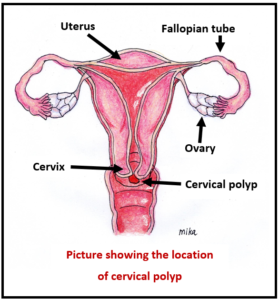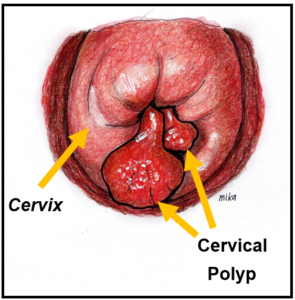A cervical polyp is a benign fleshy growth on the cervix. The cervix is the part of the uterus that is visible during the speculum examination. It is also called the neck of the uterus. Cervical polyp arises from cells, either from the cervical canal (this type is also called an endocervical polyp) or from the outer surface of the cervix.
 Incidence
Incidence
Up to 4% of women have cervical polyps.
Cause
The exact cause is usually unknown. It can arise from any chronic inflammation of the cervix.
Symptoms and signs
- most women with polyps have no symptoms and only diagnose during routine cervical cancer screening.
- it can cause abnormal vaginal bleeding and usually presents as prolonged menstrual spotting, intermenstrual bleeding, or bleeding after sex.
- it may present as abnormal vaginal discharge.
Treatment
- polyps can be easily seen during a speculum examination and removed in the clinic. A speculum is an instrument that is inserted into the vagina to open the walls and visualized the vagina and cervix.

- the procedure to remove the polyp is called a polypectomy. It is a relatively quick and painless procedure, using a pair of forceps. If the polyp is large, then the removal may need to be done in the operating theatre and under anaesthesia.
- post polypectomy care – there may be mild cramping after polyp removal. Most women may have light bleeding soon after. Painkillers can be taken if the pain is significant (such as paracetamol, mefenamic acid, ibuprufen or celecoxib). Sexual activity should be avoided for a few days. Avoid the use of tampons till the bleeding stops. Most women can resume their usual activities within a day or two after getting a polyp removed.
- the cervical polyp can recur. However, it is not common and you should not be worried about it as long as you continue to see your doctor for the recommended cervical cancer screening interval.
Complications
Complications are rare. It can be due to the:
- Polyps – infection, abnormal excessive bleeding, increasing in size, possible pre-cancerous or cancerous change.
- Procedure (polypectomy) – pain, excessive bleeding, infection
See your healthcare provider if you develop:
- Abnormal vaginal bleeding – prolonged or excessive.
- Lower abdominal or vagina pain.
- Abnormal vaginal discharge.
- Symptoms suggestive of infection – unwell, fever, body ache, abnormal vaginal discharge
To print a pdf copy, click HERE

[mailerlite_form form_id=3]
Follow at Instagram @obgyn.com.my



 Incidence
Incidence

